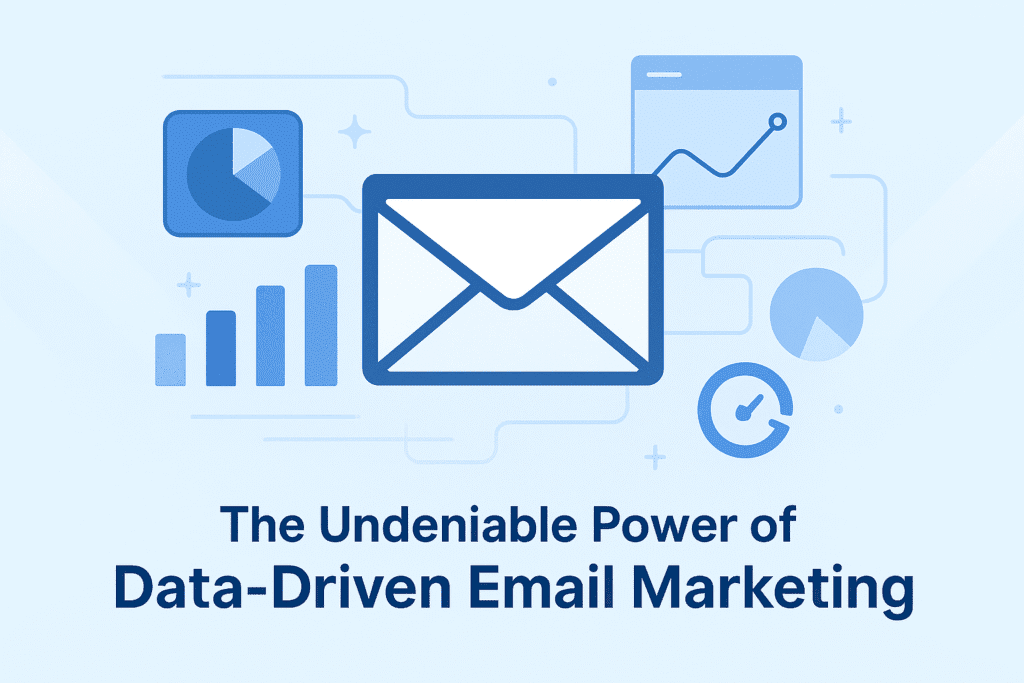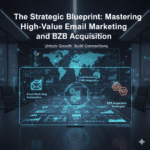The Undeniable Power of Data-Driven Email Marketing
Email marketing stands as one of the most powerful and enduring tools in the digital marketer’s arsenal. It’s a direct, personalized line to your customers, capable of nurturing deep relationships, cementing brand credibility, and, most importantly, driving significant revenue growth. However, the sheer act of sending an email campaign is merely the beginning. The true differentiator between a mediocre email strategy and one that achieves exponential success lies in the intricate science of understanding and responding to your audience’s behavior. This science is fundamentally rooted in analytics.
Far too many businesses treat their email campaigns like a lottery, hoping for the best outcome after hitting the “send” button. The savviest marketers, conversely, treat every campaign as a controlled experiment. They meticulously track, analyze, and leverage key performance indicators (KPIs) to gain valuable insights, adjust their approach, and maximize their return on investment (ROI). Ignoring your data is akin to steering a ship blindfolded; you might move forward, but you’ll never reach your desired destination efficiently.
Today, we delve beyond the surface and break down the five most crucial email marketing metrics that must be relentlessly tracked, understood, and improved upon to ensure your campaigns are not just being sent, but are truly performing.
Metric 1: Open Rate (OR) – The Gateway to Engagement
The Open Rate is the fundamental first hurdle in any successful email campaign. It’s a simple yet profound indicator of how many subscribers actually interact with your email rather than deleting it immediately or leaving it unread. It is a direct measure of your initial appeal and relevance.
Defining and Calculating Open Rate
The Open Rate is calculated by dividing the number of unique opens by the number of emails successfully delivered, and then multiplying the result by 100 to get a percentage.
$$\text{Open Rate} = \frac{\text{Unique Opens}}{\text{Emails Delivered}} \times 100$$
It is crucial to note the use of unique opens. If a single subscriber opens the same email multiple times, it only counts as one open for the purpose of this metric. This ensures the rate reflects the actual number of individuals engaging with your message.
What the Open Rate Truly Reveals
Beyond a basic engagement percentage, the Open Rate provides vital intelligence on two core aspects of your email strategy:
- Audience Content Preferences: A high Open Rate on a specific campaign theme (e.g., a “how-to” guide) compared to another (e.g., a simple product announcement) can indicate the kinds of topics or formats your audience is most eager to consume. This insight directly informs your future content calendar.
- Subject Line Effectiveness: The Open Rate is the definitive judge of your subject line quality. A compelling, relevant, and well-timed subject line is the single biggest factor influencing whether an email is opened. If your Open Rate is low, your subject lines are likely failing to pique curiosity or convey value effectively. This also extends to the preheader text, which acts as a secondary subject line, offering more context.
Strategies for Improving Your Open Rate
Improving your Open Rate requires strategic attention to the elements that appear before the email content itself.
- Master the Subject Line: Focus on clarity, urgency, and personalization. Use curiosity gaps (without being clickbait), numbers, and relevant emojis sparingly. Test subject lines with different lengths—shorter ones often perform better on mobile devices.
- Segment Your List: Sending generic emails to your entire list guarantees a lower Open Rate. By dividing your subscribers based on demographics, purchase history, geographic location, or engagement level, you can send highly relevant content, which dramatically increases the likelihood of an open. (Link: Detailed Guide to Email List Segmentation)
- Optimize Send Time: There is no universal best time to send. Test different days of the week and different times of the day. A marketing B2B audience might open emails early on a Tuesday, while a consumer-focused audience might engage more on a Sunday evening.
- Maintain List Health: Regularly remove or re-engage inactive subscribers. A smaller, highly engaged list will always deliver a higher, more valuable Open Rate than a large list padded with subscribers who never open.
Metric 2: Click-Through Rate (CTR) – Measuring Content Performance
Securing the open is the crucial first step, but it is merely the entry point. The true measure of your email’s content quality and its ability to persuade is the Click-Through Rate (CTR). This metric tells you what percentage of your recipients clicked on one or more links within your email.
Defining and Calculating Click-Through Rate
The CTR is a reflection of how successful your email was at getting the subscriber to take the next step. It is calculated by dividing the number of unique clicks by the total number of emails delivered, and then multiplying by 100.
$$\text{Click-Through Rate} = \frac{\text{Unique Clicks}}{\text{Emails Delivered}} \times 100$$
A related, and often more insightful, metric is the Click-to-Open Rate (CTOR), which measures clicks only against those who opened the email:
$$\text{Click-to-Open Rate} = \frac{\text{Unique Clicks}}{\text{Unique Opens}} \times 100$$
A high CTR coupled with a low CTOR might suggest you’re reaching the right people (high opens) but your content is weak. A low CTR and a high CTOR means your content is great, but your subject lines are preventing enough people from seeing it.
Uncovering Design and Message Flaws
If your Open Rate is healthy but your CTR is disappointingly low, it signals an issue within the body of your email. The content failed to deliver on the promise of the subject line, or the path to action was unclear.
Key areas the CTR can highlight for improvement include:
- Email Design and Layout: Is the content easy to scan? Is the email mobile-responsive? Cluttered, dense, or poorly formatted emails will deter clicks.
- Information Delivery: Did you provide too much information, satisfying the user’s need entirely within the email and removing the need to click? Or, conversely, did you provide too little context for them to feel confident clicking through?
- Call-to-Action (CTA) Clarity: The CTA must be immediately visible and unambiguous. Poorly worded CTAs (“Click Here”) or the inclusion of too many conflicting CTAs (“Buy Now,” “Download Guide,” and “Watch Video”) can paralyze the subscriber, resulting in no action at all.
Advanced Strategies for Boosting Your CTR
To optimize for clicks, shift your focus to the interior of the email.
- Prioritize a Single Goal: While it’s tempting to include everything, a high-performing email usually focuses on one primary goal and one dominant CTA. Make this CTA stand out using bright colors, ample white space, and action-oriented language.
- Harness Visual Appeal: Use high-quality, relevant images to break up text and guide the reader’s eye toward the main CTA. Image links often garner more clicks than text links alone.
- Personalize Content Blocks: Beyond just the name, use dynamic content blocks based on segmentation data. For instance, show product recommendations based on a subscriber’s past purchases or browsing behavior.
- Employ A/B Testing: Consistently test variations of your email. Experiment with CTA button text, placement, color, and size. Test image versus text-only emails, and long-form versus short-form copy. Leading email marketing platforms offer built-in A/B testing tools that make this process seamless. (Link: Best Practices for A/B Testing Email Campaigns)
Metric 3: Conversion Rate (CR) – The Ultimate Measure of Value
The Conversion Rate is arguably the most vital metric, as it connects your email activity directly to your business goals. It answers the fundamental question: Are subscribers taking the action you intended when you sent the email? This is the metric that directly translates email effort into tangible ROI.
Defining and Calculating Conversion Rate
The Conversion Rate (CR) determines the percentage of your email recipients who completed the desired target action. This target action can be anything from a direct purchase or a demo sign-up to filling out a lead form or downloading an eBook.
$$\text{Conversion Rate} = \frac{\text{Subscribers Who Completed Target Action}}{\text{Emails Delivered}} \times 100$$
A high Open Rate and a good CTR are essential, but if they don’t lead to conversions, they are merely vanity metrics. The CR proves the monetary or strategic value of your campaign.
The Necessity of External Analytics Integration
Unlike the Open and Click-Through Rates, which are automatically tracked by your email service provider, effectively tracking Conversions typically requires a crucial step: integrating your email platform with an external web analytics tool, such as Google Analytics.
This integration is accomplished through the use of UTM (Urchin Tracking Module) Parameters. These are short strings of code appended to the end of your links, allowing your analytics platform to identify exactly where the visitor came from.
A typical tracked link might look like this: yourwebsite.com/landingpage?utm_source=email&utm_medium=newsletter&utm_campaign=winter_sale.
- utm_source: Identifies the traffic source (e.g.,
email). - utm_medium: Identifies the marketing medium (e.g.,
newsletter). - utm_campaign: Identifies the specific campaign (e.g.,
winter_sale).
By diligently using UTM parameters on every email link, you gain the power to attribute revenue, sign-ups, and downloads accurately to specific email campaigns, subject lines, and even audience segments. This level of data is indispensable for justifying your email budget and optimizing for maximum profitability.
Optimization and Attribution
Analyzing the Conversion Rate provides deep insights into the final stages of the customer journey:
- Landing Page Alignment: A high CTR but a low CR suggests a disconnect between the email message and the landing page experience. Does the landing page fulfill the promise of the email? Is the final conversion form simple and intuitive?
- Funnel Friction: The CR helps identify points of friction in the conversion funnel. Are users dropping off at the checkout or on a registration page? Optimizing the post-click experience is just as important as optimizing the email itself.
- Value Proposition Clarity: A low CR may indicate that the offer itself is not perceived as valuable enough to warrant the subscriber’s time or money. Testing different offers and value propositions is key.
Metric 4: Bounce Rate – Maintaining Deliverability and Reputation
The Bounce Rate is a critical metric for maintaining the health of your email list and ensuring your messages actually reach the inbox. A ‘bounce’ occurs when an email is rejected by the recipient’s mail server. Ignoring a high Bounce Rate can severely damage your sender reputation, causing future emails to be flagged as spam.

Defining and Categorizing Bounces
The Bounce Rate is calculated by dividing the total number of bounced emails by the number of emails sent.
$$\text{Bounce Rate} = \frac{\text{Total Bounces}}{\text{Emails Sent}} \times 100$$
It is essential to distinguish between the two types of bounces:
- Hard Bounces: These are permanent delivery failures, typically due to an invalid, non-existent, or permanently blocked email address. Action: Any email address that results in a hard bounce must be immediately and permanently removed from your list by your email service provider.
- Soft Bounces: These are temporary delivery failures, usually caused by a full inbox, a temporary server issue, or an overly strict spam filter. Action: Email platforms will typically attempt to re-send soft-bounced emails for a period. If an address repeatedly soft-bounces, it should be treated like a hard bounce and removed to protect your sender score.
The Impact on Sender Reputation
Internet Service Providers (ISPs) like Gmail, Outlook, and Yahoo closely monitor your Bounce Rate. A consistently high Bounce Rate signals to the ISPs that your list is outdated or poorly maintained, and they will begin to route your emails to the spam folder, even for valid subscribers.
The acceptable industry standard for a Bounce Rate is generally under 2%. Anything higher warrants immediate investigation and list cleaning.
Best Practices for Minimizing Bounces
- Utilize Double Opt-In: Implement a double opt-in process, where new subscribers must confirm their email address by clicking a link in a confirmation email. This prevents the addition of invalid or mistyped addresses.
- Regular List Validation: Use dedicated list cleaning services periodically to remove known invalid addresses, spam traps, and role-based emails (e.g.,
info@,sales@). - Monitor Sender Reputation: Use tools (like Sender Score) to monitor your reputation and address any issues proactively.
- Domain Authentication: Ensure your domain is properly authenticated using industry standards like SPF (Sender Policy Framework) and DKIM (DomainKeys Identified Mail). (Link: Guide to SPF and DKIM Setup)
Metric 5: Unsubscribe Rate – Understanding Audience Satisfaction
The Unsubscribe Rate offers a direct, albeit sometimes uncomfortable, view into audience satisfaction and list fatigue. While it can feel like a negative metric, it is actually a valuable piece of feedback that helps you refine your content strategy.
Defining and Analyzing Unsubscribe Rate
The Unsubscribe Rate is the percentage of recipients who clicked the unsubscribe link in your email.
$$\text{Unsubscribe Rate} = \frac{\text{Unsubscribes}}{\text{Emails Delivered}} \times 100$$
A healthy list will always experience some churn. The key is to keep the rate low (typically below 0.5% is considered good). A spike in unsubscribes should be a serious red flag.
Interpreting the Unsubscribe Spike
A sudden increase in unsubscribes is often tied to one of the following issues:
- List Fatigue/Over-Mailing: You are sending emails too frequently, overwhelming your subscribers and providing diminishing returns on content value.
- Content Mismatch: The content of your campaigns no longer aligns with what the subscriber signed up for or expects to receive. This often happens when you pivot your business or change your email focus.
- Poor Segmentation: You are sending offers or content that are irrelevant to a large portion of your list (e.g., sending a menswear promotion to a list segment that has only ever purchased women’s wear).
- Lack of Clear Opt-In: You may have acquired the list through a method where the subscriber didn’t explicitly opt-in for your specific content, leading to a high rate of immediate exits.
Turning Unsubscribes into Actionable Insights
Instead of viewing unsubscribes as a loss, treat them as market research.
- Analyze the Exit Page: If your email service allows it, include a brief survey on the unsubscribe page asking the user why they are leaving (e.g., “Too frequent,” “Content irrelevant,” “Not what I signed up for”). This qualitative data is gold for improving your strategy.
- Offer Preference Centers: Rather than forcing an all-or-nothing unsubscribe, offer a Subscription Preference Center. This allows the user to reduce frequency (e.g., switch from daily to weekly) or select specific topics they are interested in. This can save a large percentage of potential unsubscribers.
- Practice Good List Hygiene: Subscribers who actively opt-out are doing you a favor. They are self-identifying as unengaged, which helps keep your overall engagement rates and sender reputation high. Never try to hide or obscure the unsubscribe link—it is mandatory and trying to hide it is a spam offense.
The Path to Email Mastery
Mastering the art of email marketing is a continuous process of experimentation, analysis, and refinement. Relying on intuition alone is a recipe for wasted effort and missed opportunities. By diligently tracking, analyzing, and acting upon these five crucial metrics—Open Rate, Click-Through Rate, Conversion Rate, Bounce Rate, and Unsubscribe Rate—you gain the empirical data needed to make informed strategic decisions.
An integrated email service solution can provide you with the tools necessary to leverage this data effectively. Look for platforms that offer detailed analytics dashboards, robust segmentation options, and integrated A/B testing capabilities. These features enable you to automatically track the essential metrics, segment your audience with customizable variables based on engagement data, and deliver highly personalized, relevant campaigns that resonate with your prospects at precisely the right moment.
The true secret to success is commitment: commit to regular A/B testing, commit to analyzing the results, and commit to optimizing your email strategy based on objective data. When you do, you will not just be sending emails—you’ll be building a powerful, data-driven revenue engine.
Conclusion
Email marketing remains an unparalleled channel for driving customer lifetime value and maximizing business growth. However, its effectiveness is strictly proportional to the marketer’s commitment to measurement. The metrics we have explored—Open Rate, CTR, Conversion Rate, Bounce Rate, and Unsubscribe Rate—are not just numbers; they are the voice of your audience, providing direct feedback on the relevance of your subject lines, the quality of your content, the health of your list, and the profitability of your campaigns.
Moving forward, every email you send should be viewed as an opportunity to gather intelligence. By integrating your email platform with web analytics using tools like UTM parameters, maintaining rigorous list hygiene, and continuously refining your content and call-to-action strategies, you can transform low-performing campaigns into high-converting assets. Remember: measurement precedes improvement. Start tracking today, and watch your email marketing success skyrocket.






